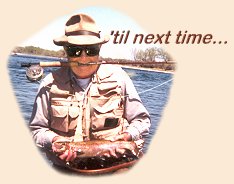Q.
From Parnelli - With exotic species like the New
Zealand mudsnail being introduced into ecosystems
where they are not native and natural predators
are absent, what ways can these new species be
controlled without having to drain the swamp so
to speak?
A.
This is less an answer to your question than it is
a general response to the problem. The short answer,
and somewhat facetious, is to kill them. The problem,
of course, is how to do this. Most control methods
introduce their own set of problems, so until good,
safe control methods are found, the emphasis must be
on trying to control their dissemination into new waters.
There is an excellent article in the recent issue of
Wild On The Fly entitled "Invasive Species" by
Hugh Gardner. In it, he discusses the problem with
exotic species that often successfully out compete
native fauna for food, space, and other resources
and the likelihood of eliminating, or more realistically,
controlling them. I won't go into all the details about
their spread, rate of propagation, etc.; you can read
these for yourself.
As you mention in your e-mail, one last-ditch effort to
control them is by introducing natural biological controls
from their source that are not present here. This approach
has its own set of problems. Although the natural parasite
may be effective in the exotic species home range, there
is no guarantee that the totality of environmental
conditions present in the new site will allow it to
act as it did previously. Will it still control the
target species in its new home? Will it turn out to
attack other desired species? Will the predator
encounter organisms that attack it? Will it upset
the new food-web in unexpected ways? The use of
biological controls must be approached with caution
and considerable research prior to initiation.
Given the absence of current biological controls to
help control or eradicate whirling disease, the New
Zealand mudsnail, the Zebra mussel, water hyacinth,
tamarisk, and other plants and animals, what can
anglers do? Mr. Gardner argues for greater efforts
by anglers to be sure that they aren't agents for
spreading these organisms by making sincere efforts
to clean their equipment -waders, boats, trailers,
etc. - to be sure that they are not transporting
organisms or propagules to new sites.
Mr. Gardner alludes to efforts by several groups,
notable the Federation of Fly Fishers, to come up
with some guidelines for anglers in this battle.
An interesting note is that some representatives
of the travel industry say that it is not unreasonable
to not only undergo stringent inspections of your
fishing equipment when you travel to different countries,
but in the future you may be able to bring in only
new equipment! Who said this was a poor man's sport?
~ C. E. (Bert) Cushing, aka Streamdoctor
105 W. Cherokee Dr.
Estes Park, CO 80517
Phone: 970-577-1584
Email: streamdoctor@aol.com
 The 'Stream Doctor' is a retired professional stream ecologist and
author, now living in the West and spending way too much time
fly-fishing. You are invited to submit questions relating to
anything stream related directly to him for use in this Q & A Feature
at streamdoctor@aol.com.
The 'Stream Doctor' is a retired professional stream ecologist and
author, now living in the West and spending way too much time
fly-fishing. You are invited to submit questions relating to
anything stream related directly to him for use in this Q & A Feature
at streamdoctor@aol.com.
|

 The 'Stream Doctor' is a retired professional stream ecologist and
author, now living in the West and spending way too much time
fly-fishing. You are invited to submit questions relating to
anything stream related directly to him for use in this Q & A Feature
at
The 'Stream Doctor' is a retired professional stream ecologist and
author, now living in the West and spending way too much time
fly-fishing. You are invited to submit questions relating to
anything stream related directly to him for use in this Q & A Feature
at